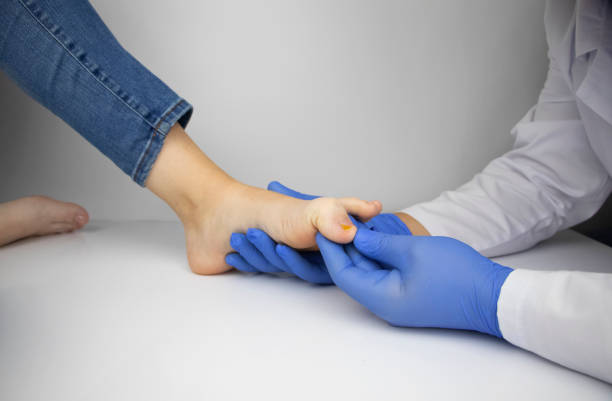Knowing When to Seek Help From a Podiatrist
As the old saying goes, “An ounce of prevention is worth a pound of cure.” This certainly applies to your feet and ankles.
Seeing a podiatrist early on can prevent future foot and ankle problems, like bunions, hammer toes or flat feet. Knowing when to seek help from a podiatrist can make your feet and legs feel great all day long.

Pain or Numbness in Your Feet
A podiatrist is an excellent choice for people with numb feet or foot injuries. A lack of sensation in your feet can increase your risk for falls and makes it harder to feel a small cut or blister that could become serious if left untreated.
Numbness in your feet can be temporary and usually results from a reduction of blood flow or pressure on nerves. But numbness that persists or becomes permanent may be a sign of an underlying condition.
Unexplained bruising in your feet should be evaluated by a doctor as well. Bruising can be an indicator of an injury or a health issue, such as diabetes or kidney disease.
Swelling or Redness in Your Ankles or Toes
A common sign that it’s time to see a podiatrist is when you experience persistent pain and redness in your feet and ankles. Chronic foot and ankle pain can indicate a number of conditions including arthritis, sprains and fractures.
Swelling in your legs and feet is also a common sign that you should visit a podiatry clinic . Swelling, or edema, is caused by problems with your veins that prevent blood from moving up your legs and back to your heart. This can be a result of an injury, a blood clot or venous insufficiency.
A podiatrist can diagnose the underlying cause of your swollen legs and prescribe treatment accordingly.
Bunions
Bunions are hard bumps that form on the outside of your big toe joint. They are often painful and can interfere with daily activities. Bunions are also a sign of other conditions that put you at risk for foot-related problems like arthritis and hammer toe.
Bunions develop slowly over time, as the bones in your foot shift and stretch out some ligaments while tightening others. Those with flat feet, low arches or unstable joints are at a higher risk of developing bunions. People who wear shoes with a narrow toe box or heels, particularly women, are also at risk.
Doctors diagnose bunions by doing a physical exam of the foot and toes. They may also order an X-ray.

Painful Corns or Calluses
Often painless corns or calluses are just a cosmetic issue but when they are painful you should let a Thornbury podiatrists know. Never attempt to shave or pick at a callus yourself because you could damage healthy tissues underneath.
Calluses and corns are areas of thickened skin that protect against friction or pressure. They usually form on the soles of the feet or palms of the hands.
They can be caused by a medical condition that changes the normal alignment of the bones of your foot such as arthritis, bunions or hammertoes. They can also be due to the way you walk or use your feet which could cause certain areas of the foot to be overloaded e.g. the ball of your foot.
Athlete’s Foot
Athlete’s foot, also known as tinea pedis, is a fungal infection characterized by scaly, itchy skin between the toes. It spreads easily, usually in damp environments like showers and locker rooms, and by rubbing off on the hands and other body parts and spreading to new locations.
A podiatrist can help treat athlete’s foot by examining the affected area, taking scrapings and using a microscope to look for fungi. They may recommend over-the-counter antifungal ointments or powders and suggest changes to your footwear. They might also prescribe oral medication for severe cases.
Plantar Warts
Human papillomavirus (HPV) causes warts to grow in cracks and tiny cuts on the bottom of your feet. When left untreated, plantar warts can swell to an inch or more in circumference and develop into clusters of multiple warts known as mosaic warts.
Most warts are harmless, but they can be painful if you step on them. They can also spread by being scratched or buffed with an emery board or pumice stone.
Your podiatrist can use stronger peeling medicines with salicylic acid or plantar fasciitis treatment to remove your warts one layer at a time, with regular home application and office visits. They may also use a chemical burn called cantharidin to cause the warts to blister and fall off your foot.
Gout
Gout is a form of arthritis that causes pain and swelling in the joints. It often affects the big toe joint, but it can also affect other joints in the feet and ankles. It occurs when the body makes too much uric acid, which can build up in the joints and tissues. A podiatrist can prescribe drugs that lower urate levels to prevent gout attacks.
People with diabetes should see a podiatrist annually to have their feet examined for signs of foot ulcers or serious problems such as neuropathy, which can cause numbness in the feet and toes. A podiatrist can provide a range of treatments for these conditions, including orthotics and medication.
New Exercise Routine
Podiatrists can help with a wide variety of issues related to the feet and ankles, including recommending orthotics or other supportive devices. They can also help prevent issues like bunions and hammertoes by performing regular examinations.
Even healthy individuals should see a podiatrist at least once a year for a general foot exam. This can help detect early signs of disease, reduce the risk of injury and promote overall well-being. Diabetics in particular should see a podiatrist regularly to help prevent serious foot problems, such as loss of sensation and open wounds that could lead to amputation. Studies show that incorporating podiatrists into diabetic care significantly lowers the risk of amputation.
